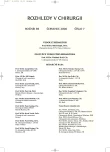Classification-Based Surgical Approach in Surgical Management of Thoracolumbar Fractures of the Spine
Authors:
R. Lukáš; P. Suchomel *; J. Šrám; L. Endrych **
Authors‘ workplace:
Traumacentrum, Neurocentrum (*) a radiodiagnostické oddělení (**) Krajské nemocnice Liberec
Published in:
Rozhl. Chir., 2006, roč. 85, č. 7, s. 365-372.
Category:
Monothematic special - Original
Overview
Introduction:
The decision on the surgical approach in the operative treatment of the fractures of thoracolumbar spine is possible only by following a detailed classification. However, the application of the classification systems is not reliable without a complex imagination of the bony and fibrous structures involved into the fracture. Pre-op investigation should include x-rays, CT-scans and MRI.
Material and methods:
Patient series consists of 21 females and 43 males treated surgically for the unstable thoracolumbar fracture during 2001. The average age was 43 years. Patients suffering form osteoporosis, fresh spinal cord injury and multiple spine fractures were excluded. All fractures were examined by plain x-rays, CT-scans and MRI and classified according the AOASIF classification system. In patients with A-type fractures the single anterior approach was used. Patients with B- or C-type of fracture were operated by the posterior approach. These fractures were complementary classified according to the Load-sharing classification and those with 6 or more points were additionally operated also from the front. Patients were divided into the three groups: the anterior approach (22 pts), the combined procedure (22 pts) and the posterior approach (20 pts). In the third group, the hardware was removed after 15 months on average. No posterolateral fusion was carried out. Minimum follow-up was 22 months.
Results:
No implant failure was found in any patient. No significant loss of correction was found in the first and the second group. The loss of correction in the third group was 3.1 degree on average.
Conclusion:
Overall graphical imagination of the thoracolumbar fractures (including MRI) is essential for their classification. The classification helps to choose the optimum surgical approach. The approach related to the fracture classification prevents the treatment failure.
Key words:
spine stability – thoracolumbar fractures – fracture classification – magnetic resonance imaging – surgical approach
Labels
Surgery Orthopaedics Trauma surgeryArticle was published in
Perspectives in Surgery

2006 Issue 7
Most read in this issue
- Atypically Localised Hepatic Haemangioma as a Cause of Dyspeptic Syndrome
- Laparoscopic Procedure According to Heller
- Duplication of the Terminal Ileum – A Case Review
- Incisional Hernias – the Ramireze Corrective Procedure
